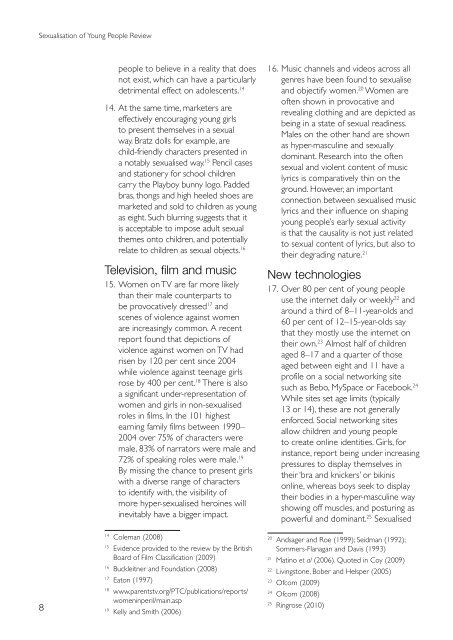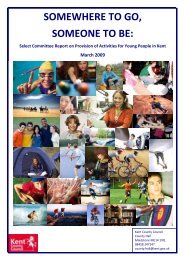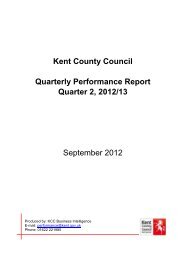Sexualisation of Young People Review
Sexualisation of Young People Review
Sexualisation of Young People Review
Create successful ePaper yourself
Turn your PDF publications into a flip-book with our unique Google optimized e-Paper software.
<strong>Sexualisation</strong> <strong>of</strong> <strong>Young</strong> <strong>People</strong> <strong>Review</strong><br />
8<br />
people to believe in a reality that does<br />
not exist, which can have a particularly<br />
detrimental effect on adolescents. 14<br />
14. At the same time, marketers are<br />
effectively encouraging young girls<br />
to present themselves in a sexual<br />
way. Bratz dolls for example, are<br />
child‐friendly characters presented in<br />
a notably sexualised way. 15 Pencil cases<br />
and stationery for school children<br />
carry the Playboy bunny logo. Padded<br />
bras, thongs and high heeled shoes are<br />
marketed and sold to children as young<br />
as eight. Such blurring suggests that it<br />
is acceptable to impose adult sexual<br />
themes onto children, and potentially<br />
relate to children as sexual objects. 16<br />
Television, film and music<br />
15. Women on TV are far more likely<br />
than their male counterparts to<br />
be provocatively dressed 17 and<br />
scenes <strong>of</strong> violence against women<br />
are increasingly common. A recent<br />
report found that depictions <strong>of</strong><br />
violence against women on TV had<br />
risen by 120 per cent since 2004<br />
while violence against teenage girls<br />
rose by 400 per cent. 18 There is also<br />
a significant under-representation <strong>of</strong><br />
women and girls in non-sexualised<br />
roles in films. In the 101 highest<br />
earning family films between 1990–<br />
2004 over 75% <strong>of</strong> characters were<br />
male, 83% <strong>of</strong> narrators were male and<br />
72% <strong>of</strong> speaking roles were male. 19<br />
By missing the chance to present girls<br />
with a diverse range <strong>of</strong> characters<br />
to identify with, the visibility <strong>of</strong><br />
more hyper-sexualised heroines will<br />
inevitably have a bigger impact.<br />
14<br />
Coleman (2008)<br />
15<br />
Evidence provided to the review by the British<br />
Board <strong>of</strong> Film Classification (2009)<br />
16<br />
Buckleitner and Foundation (2008)<br />
17<br />
Eaton (1997)<br />
18<br />
www.parentstv.org/PTC/publications/reports/<br />
womeninperil/main.asp<br />
19<br />
Kelly and Smith (2006)<br />
16. Music channels and videos across all<br />
genres have been found to sexualise<br />
and objectify women. 20 Women are<br />
<strong>of</strong>ten shown in provocative and<br />
revealing clothing and are depicted as<br />
being in a state <strong>of</strong> sexual readiness.<br />
Males on the other hand are shown<br />
as hyper-masculine and sexually<br />
dominant. Research into the <strong>of</strong>ten<br />
sexual and violent content <strong>of</strong> music<br />
lyrics is comparatively thin on the<br />
ground. However, an important<br />
connection between sexualised music<br />
lyrics and their influence on shaping<br />
young people’s early sexual activity<br />
is that the causality is not just related<br />
to sexual content <strong>of</strong> lyrics, but also to<br />
their degrading nature. 21<br />
New technologies<br />
17. Over 80 per cent <strong>of</strong> young people<br />
use the internet daily or weekly 22 and<br />
around a third <strong>of</strong> 8–11-year-olds and<br />
60 per cent <strong>of</strong> 12–15-year-olds say<br />
that they mostly use the internet on<br />
their own. 23 Almost half <strong>of</strong> children<br />
aged 8–17 and a quarter <strong>of</strong> those<br />
aged between eight and 11 have a<br />
pr<strong>of</strong>ile on a social networking site<br />
such as Bebo, MySpace or Facebook. 24<br />
While sites set age limits (typically<br />
13 or 14), these are not generally<br />
enforced. Social networking sites<br />
allow children and young people<br />
to create online identities. Girls, for<br />
instance, report being under increasing<br />
pressures to display themselves in<br />
their ‘bra and knickers’ or bikinis<br />
online, whereas boys seek to display<br />
their bodies in a hyper-masculine way<br />
showing <strong>of</strong>f muscles, and posturing as<br />
powerful and dominant. 25 Sexualised<br />
20<br />
Andsager and Roe (1999); Seidman (1992);<br />
Sommers-Flanagan and Davis (1993)<br />
21<br />
Matino et al (2006). Quoted in Coy (2009)<br />
22<br />
Livingstone, Bober and Helsper (2005)<br />
23<br />
Ofcom (2009)<br />
24<br />
Ofcom (2008)<br />
25<br />
Ringrose (2010)

















